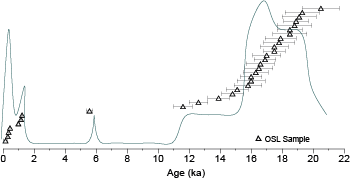Current Research
Past aeolian activity
Coastal dunes represent the inland extension of sandy coastal system. They are shaped by the winds though the sand is sourced from the adjacent emerged beaches. Thus, dune state and history can provide relevant infomation regarding the overall coastal sediment budget as the volume of transfered sediment depends on the wind power and on the coastal sediment budget. The latter will determine the type of coastal dunes in terms of migration; regressive dunes will form on prograding coasts while transgressive dunes will occupy the inland region of retrograding coasts. In this regard, dune archive can inform about major shoreline trends and windiness shifts.
Traditionally, continental aeolian deposits have concentrated the attention of researchers interested on exploring the record of aeolian activity. However, examples of research carried out in coastal dunes have proved their potential unraveling major shoreline and wind shifts. A good example is the work we have been developing along the Portuguese coast, in particular in the coastal stretch located to the south of Lisbon (Costas et al. 2012).
The Portuguese coast is dominated by massive deposits of fixed transgressive dunes, while the active formation of transgressive dunes at present is anecdotal. A major motivation behind the investigation of past aeolian activity consists on understanding What were the major drivers behind such a landscape shift? Can we use the record of aeolian activity as an indicator of past environmental conditions? and Why present day shores are sand depleted?
To answer these questions, we have integrated sedimentology, geophysical, chronological and paleoclimate information and compared these with present day analogs obtained from observed and hindcasted winds. Dune stratigraphy was explored using a Ground Penetrating Radar, which supported us on the selection of samples for dating the ages of the identified units. Ages were determined by Optically Stimulated Luminescence.
Results of this on going research document the occurrence of discrete episodes of enhanced aeolian activity and inland sediment transference through the migration of transgressive dunes between 20 ka and 300 years ago.

Fig. OSL results showing the episodes of aeolian activity from 20 ka.
Present and recent aeolian activity
Historically, coastal dunes have been threaten by the intense occupation of the coast, which has determined the evolution of these systems around the world. In some cases, the pressure exerted by human activities in the coast has provoked their total destruction while in some other cases human pressure has determine dune evolution by controlling dune fixation by vegetation.
Over the last centuries, populations have insistently fought to stop the advance of the sand over their properties artificially fixing the dunes. Nowadays, coastal dunes are mostly fixed though a big effort is being done in some areas to artificially rebuilt frontal dunes to prevent shoreline retreat. Alternatively, new works appeal to our ecological conscience pointing towards the possibility of habitat disappearance as the extension of moving and bare sand dunes decreases if increasing vegetation cover trends persist. Indeed, some attempts have been made to transform fixed dunes into mobile dunes through vegetation destruction. However, it has been demonstrated that the punctual destruction of the vegation is not enough to maintain mobile dunes. Thus, the success of these measures depends on the continuous management of the dunes (Bar 2013).
This framework raises several questions when we compare past aeolian activity with the record of recent and present aeolian activity. In this regard, the first question is related to the actual drivers of dune fixation in the past. When did transgressive dunes actively move for the last time along our coasts? Were those dunes artificially or naturally fixed? And more importantly, why did humans have to fight against dune advance in the past and against dune fixation at present?
To answer these questions I am exploring the recent record of aeolian activity, including the last hundreds of years (using historical archives and OSL dating) and the last decades (using aerial photographs). The idea is to identify the drivers behind aeolian activation and fixation through time and see to which extent recent aeolian activation/fixation is driven by human activities and/or climate variability.

Contact info:
Centro de Inv. Marinha e Ambiental - CIMA
Universidade do Algarve
Campus de Gambelas, Edifício 7
8005-139 Faro PORTUGAL
+351 289 800900 (ext. 7898)
E-mail: scotero@ualg.pt
